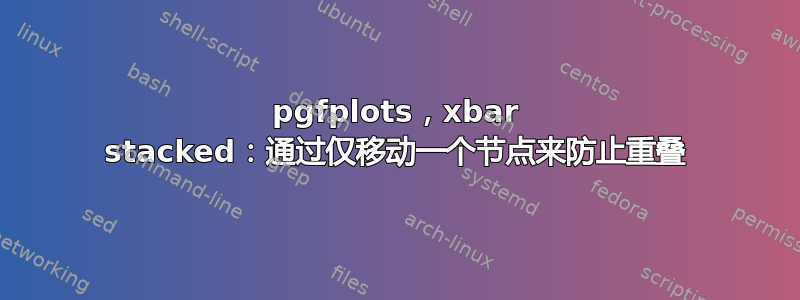
以下示例导致两个重叠节点(第 0 行第 4 列和第 5 列):
\documentclass{standalone}
\usepackage{pgfplots,pgfplotstable}
\pgfplotsset{%
,xmin=0%
,/tikz/font=\footnotesize%
,compat=1.11%
}
\begin{document}
\pgfplotstableread[col sep=comma, header=false]{%
B,54,30,11,4.6,0.4
A,9.3,20.8,17.8,30.5,21.6
}{\datatable}
\begin{tikzpicture}
\begin{axis}[%
xbar stacked,%
x post scale=1.3,%
ytick=data,%
nodes near coords,%
]
\addplot+ table [x=1, y expr=\coordindex]
{\datatable};
\addplot+ table [x=2, y expr=\coordindex]
{\datatable};
\addplot+ table [x=3, y expr=\coordindex]
{\datatable};
\addplot+ table [x=4, y expr=\coordindex]
{\datatable};
\addplot+ table [x=5, y expr=\coordindex]
{\datatable};
\end{axis}
\end{tikzpicture}
\end{document}
结果:
我找到了改变的方法全部第 5 列的节点:
\documentclass[convert]{standalone}
\usepackage{pgfplots,pgfplotstable}
\pgfplotsset{%
,xmin=0%
,/tikz/font=\footnotesize%
,compat=1.11%
}
\begin{document}
\pgfplotstableread[col sep=comma, header=false]{%
B,54,30,11,4.6,0.4
A,9.3,20.8,17.8,30.5,21.6
}{\datatable}
\begin{tikzpicture}
\begin{axis}[%
xbar stacked,%
x post scale=1.3,%
ytick=data,%
]
\addplot+[nodes near coords] table [x=1, y expr=\coordindex]
{\datatable};
\addplot+[nodes near coords] table [x=2, y expr=\coordindex]
{\datatable};
\addplot+[nodes near coords] table [x=3, y expr=\coordindex]
{\datatable};
\addplot+[nodes near coords] table [x=4, y expr=\coordindex]
{\datatable};
\addplot+[%
nodes near coords={%
\hspace{.5cm}\pgfmathprintnumber\pgfplotspointmeta%
},%
every node near coord/.append style=black%
] table [x=5, y expr=\coordindex]
{\datatable};
\end{axis}
\end{tikzpicture}
\end{document}
结果:
但我只想移动那些与其他节点重叠的节点。第 1 行的第 5 列不应移动。有什么想法吗?理想情况下,该解决方案可以应用于我所有的堆积条形图,因为有许多条形图具有重叠节点。我正在寻找类似的东西node near coord in row x。在此示例中,较高的值x post scale不起作用,因为图会超过\linewidth。
答案1
这里我提出一个解决方案,向上或向下移动全部 nodes near coords低于给定阈值,即无论它们在哪里。这可以最大限度地降低两个或多个小条节点相互重叠的风险。
请查看代码中的注释以了解更多详细信息。
% used PGFPlots v1.15
\documentclass[border=5pt]{standalone}
\usepackage{pgfplots}
\usepackage{pgfplotstable}
\pgfplotsset{
% use this `compat` level or higher to place `nodes near coords`
% in the middle of the bars and show only the increment value
compat=1.9,
xmin=0,
/tikz/font=\footnotesize,
}
\begin{document}
\pgfplotstableread[col sep=comma, header=false]{
B,54,30,11,4.6,0.4
A,9.3,20.8,17.8,30.5,21.6
}{\datatable}
\begin{tikzpicture}
\begin{axis}[
% reduce the `height' of the plot ...
height=65pt,
% ... but avoid changing the default `width' which is scaled from
% that width ...
width=\axisdefaultwidth,
x post scale=1.3,
% ... and only scale the axis
scale only axis,
% enlarge the y limits so there is enough space above it to
% place there a possible `node near coord'
enlarge y limits={abs=0.7},
xbar stacked,
ytick=data,
% show `nodes near coords' but adapt the style so that values
% below a threshold are shifted upwards by the given amount
nodes near coords,
% (check here for the value and store the shift value in `\myshift')
visualization depends on={
ifthenelse(meta>5,0pt,(-1)^\plotnum * 10pt) \as \myshift
},
% % -----------------------------------------------------------------
% % ~~~ simple solution where was no need for changing node styles
% % (apply that `\myshift' here in the `nodes near coords style')
% nodes near coords style={
% yshift=(\myshift),
% },
% -----------------------------------------------------------------
% ~~~ advanced solution where different node styles are needed
% nodes that should be moved up/down
% (adapted from <http://tex.stackexchange.com/a/141006/95441>)
% #1: the THRESHOLD after which we switch to a special display.
nodes near coords moved up/.style={
% define the style of the nodes with "small" values
small value/.style={
text=black,
yshift=\myshift,
},
% define the style of the nodes with "large" values
large value/.style={
% I choose red here because white didn't look that good
text=red,
},
every node near coord/.style={
check for zero/.code={
\pgfmathfloatifflags{\pgfplotspointmeta}{0}{
% If meta=0, make the node a coordinate
% (which doesn't have text)
\pgfkeys{/tikz/coordinate}
}{
\begingroup
% this group is merely to switch to FPU locally.
% Might be unnecessary, but who knows.
\pgfkeys{/pgf/fpu}
\pgfmathparse{\pgfplotspointmeta<#1}
\global\let\result=\pgfmathresult
\endgroup
%
% simplifies debugging:
%\show\result
%
\pgfmathfloatcreate{1}{1.0}{0}
\let\ONE=\pgfmathresult
\ifx\result\ONE
% AH: our condition 'y < #1' is met.
\pgfkeysalso{/pgfplots/small value}
\else
% ok, proceed as usual.
\pgfkeysalso{/pgfplots/large value}
\fi
}
},
check for zero,
},
},
% assign a value to the new style which is the threshold at which
% the two style `small value' or `large value' are used
nodes near coords moved up=5,
% -----------------------------------------------------------------
]
\addplot table [x index=1, y expr=\coordindex] {\datatable};
\addplot table [x index=2, y expr=\coordindex] {\datatable};
\addplot table [x index=3, y expr=\coordindex] {\datatable};
\addplot table [x index=4, y expr=\coordindex] {\datatable};
\addplot table [x index=5, y expr=\coordindex] {\datatable};
\end{axis}
\end{tikzpicture}
\end{document}





